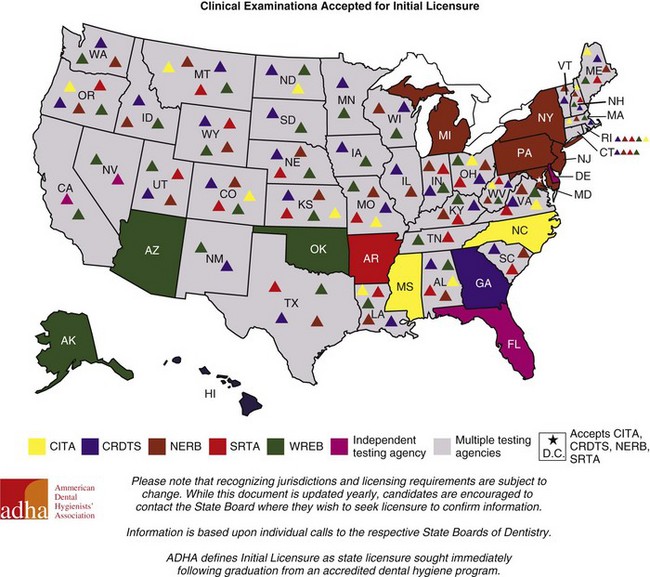Preparing for National, Regional, and State Dental Hygiene Board Examinations
Dental Hygiene Licensure
• Graduation from a dental hygiene program accredited by the Commission on Dental Accreditation (CODA) or, based on reciprocity, by the Commission on Dental Accreditation of Canada (CDAC)
• Successful completion of the NBDHE
• Successful completion of a regional or state clinical board examination
It should be noted that recognition of an accrediting agency is a governmental function. In health care fields with a domain of specialized education, accreditation is conducted by a dedicated agency within the profession. In dentistry, the U.S. Department of Education (USDE) has recognized the CODA of the American Dental Association (ADA) as the official accrediting body for schools of dentistry, dental hygiene, dental assisting, and dental laboratory technology. The CODA is also listed in the publications of accreditation agencies by the Council for Higher Education Accreditation (CHEA). A diploma, certificate, associate’s degree, or baccalaureate degree in dental hygiene indicating graduation from an accredited program is an essential component for licensure that is based on the accreditation system carried out under the auspices of the CODA. States that provide for licensure of a dentist or dental hygienist from a nonaccredited school generally require evidence of an educational program that is equivalent to an accredited program. The NBDHE is developed and administered by the Joint Commission on National Dental Examinations (JCNDE). Client-based clinical examinations are conducted by five regional testing agencies (Boxes 1-1 and 1-2). The licensure boards of California, Delaware, Florida, and the Virgin Islands of the United States administer independent examinations. Nevada, administers the American Dental Hygiene Licensing Examination (ADHLEX). Clinical examinations accepted for initial licensure are shown in Figure 1-1.

FIGURE 1-1 Clinical examinations accepted for licensure. (From the American Dental Hygienists’ Association.
Applicants for dental hygiene licensure must contact the state licensing board for current requirements and procedures (Box 1-3).
State Boards of Dentistry/Dental Hygiene and Professional Associations
• Enforcing the state practice act and its rules and regulations
• Conducting or recognizing examinations for competence
• Reviewing and investigating complaints concerning unlawful or unprofessional conduct by licensees
Significant variations exist from jurisdiction to jurisdiction in the way regulatory boards are organized, in the power or authority they have, and even in their titles. For the purpose of clarity in this text, the term state board or state board of dentistry is used to refer to the regulatory body in a respective legal jurisdiction that is empowered to determine prerequisites for licensure and issue licenses to practice dental hygiene (see Box 1-3).
Stay updated, free dental videos. Join our Telegram channel

VIDEdental - Online dental courses


